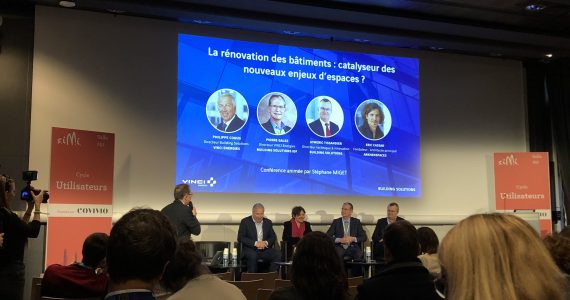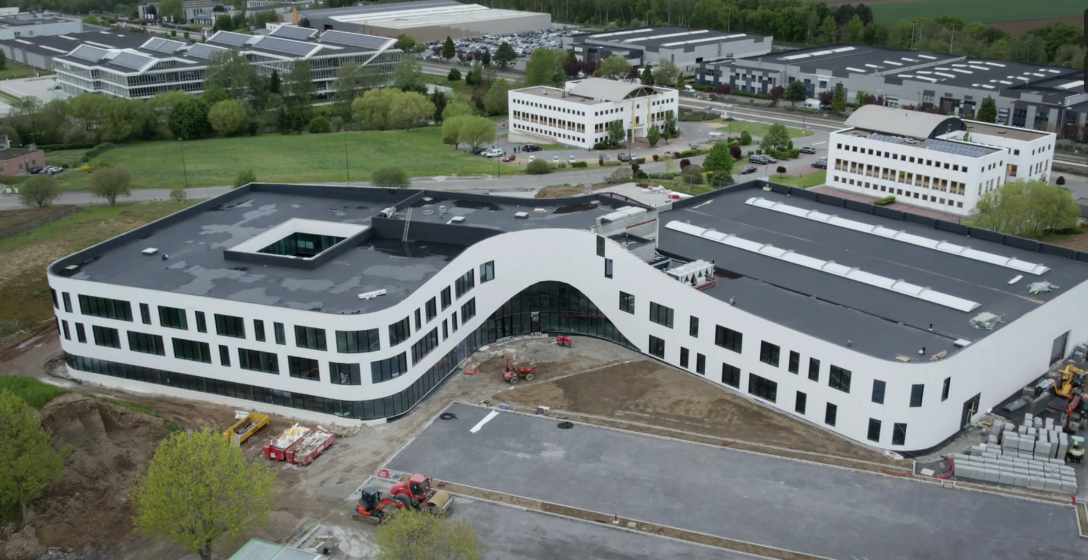
Building renovation, a catalyst for new ways of using space?
The SIMI real estate exhibition was held from 11 to 13 December. On this occasion, our Building Solutions experts gave a presentation with the title “Building renovation: a catalyst for new ways of using space?”. Participants were Building Solutions Director Philippe Conus, Technical and Innovation Director Aymeric Tissandier, VINCI Energies IdF Director Pierre Gales and architect Eric Cassar from the Arkhenspaces firm. This article sets out the main thrust of the presentation.
Philippe Conus opened the presentation with the following observation: “The building sector is a key environmental issue, since it accounts for 45% of energy consumption and 25% of greenhouse gas emissions. It also generates about 40% of all waste, far more than the transport sector.”
He then listed the main issues to be tackled in three points:
• Supporting the energy transition, since building construction is one of the sectors that consumes the most energy in France. Sector participants have a major responsibility to help achieve the very ambitious European and national level targets (tertiary decree, energy climate law).
• Support changes in the use of space to accommodate new patterns of work and mixed-use property combining housing, shops and office space.
• Support technological change with the advent of digital technologies, digitalisation of property and technical assets and changes in building management systems (BMS) which increasingly use IT.
“These three goals apply to all types of building and especially to the very large existing stock. It is estimated that in Europe, 70% of buildings are currently energy inefficient and fewer than 1% of these buildings are refurbished each year. We therefore have a huge amount of work ahead of us,” said Philippe Conus by way of introduction.
Aymeric Tissandier then focused on using the carbon impact concept to meet the environmental challenge. “Renovation does not necessarily have a positive impact on carbon, but it has an impact. We must be able to measure it. This consists, for every building construction project, in measuring the impact of these activities on GHG emissions, from raw materials to transport, the energy cost of the construction process and the manufacture of equipment. Impact is measured in tonnes of CO2 equivalent. This measurement starts with construction but covers the entire building life cycle.”
Pierre Gales then added, on this point, “The benefit of a renovation is to minimise this impact. For example, changing all the windows in a building is costly and the carbon reduction benefits are sometimes not commensurate, when the carbon return exceeds the life of the windows. It is therefore sometimes wiser to invest in refurbishing some of the joinery and insulating the interior of the facade.”
The strength of the Building Solutions network is that it coordinates our maintenance and works companies in a move to gain a comprehensive overview of the renovation throughout the building’s lifecycle.
Aymeric Tissandier and Pierre Gales stress this point. “We will succeed in submitting the best bid when we have a comprehensive vision and work together. In addition, all our business lines must communicate with each other and with the full range of stakeholders – architects and clients.”
The round table then turned to the digital and work organisation aspects of a renovation, supported by the recent collaboration between VINCI Facilities and architect Eric Cassar in drawing up the white paper entitled “Ensemble, travailler en c(h)oeur – Nouveaux usages et nouveaux espaces à l’ère du digital“ (“Working together – New patterns of work and new work spaces in the digital era” – in French only), which puts changing patterns of work and the ways in which our business activities must accommodate them into perspective.
Eric Cassar highlighted a number of key points made in the white paper. “Previously, renovation took a passive approach to the building. Today we need to focus on its diversity. The concept of movement is very important. In the past, an architect arranged spaces next to each other and they stayed the same over time. Now these spaces are starting to move. This is where the concept of space coordination comes in – transforming spaces according to need in near real-time. This change also involves digital technology.
“With digital technology the right energy can be brought to bear in the right place at the right time. We can recreate temperature gradients, design spaces that better meet our needs and create an ideal atmosphere that changes according to the season and location.”
To meet these ambitious goals, the moderator looked at the way the Building Solutions companies are managing to address the technical and service needs of their customers.
Aymeric Tissandier took the floor again to say, “We will need to innovate in materials and working methods, using appropriate tools to estimate the carbon footprint and manage buildings, as well as tools to assess renovation scenarios. To do this, we are already working with the HELIOS Exchange solution, which gives us an energy twin for the building that displays the best action to take to boost energy efficiency.”
Lastly, Pierre Gales concluded the round table on a strong positive note. “Our job in the energy sector is central to these new issues and is very exciting. It is a major challenge, but I believe we are building something really great.”
Philippe Conus added, “I am confident that a successful renovation project involves getting all the participants – building operators, builders, architects and installers – together and combining the various economic, environmental and social goals to create value for all of them.”
Did you like the article ?



